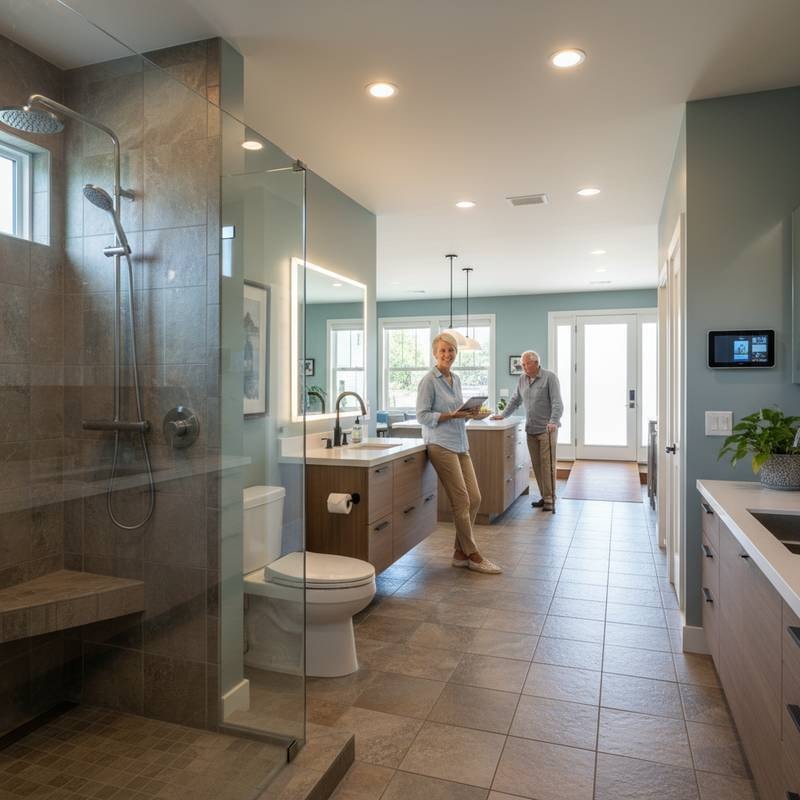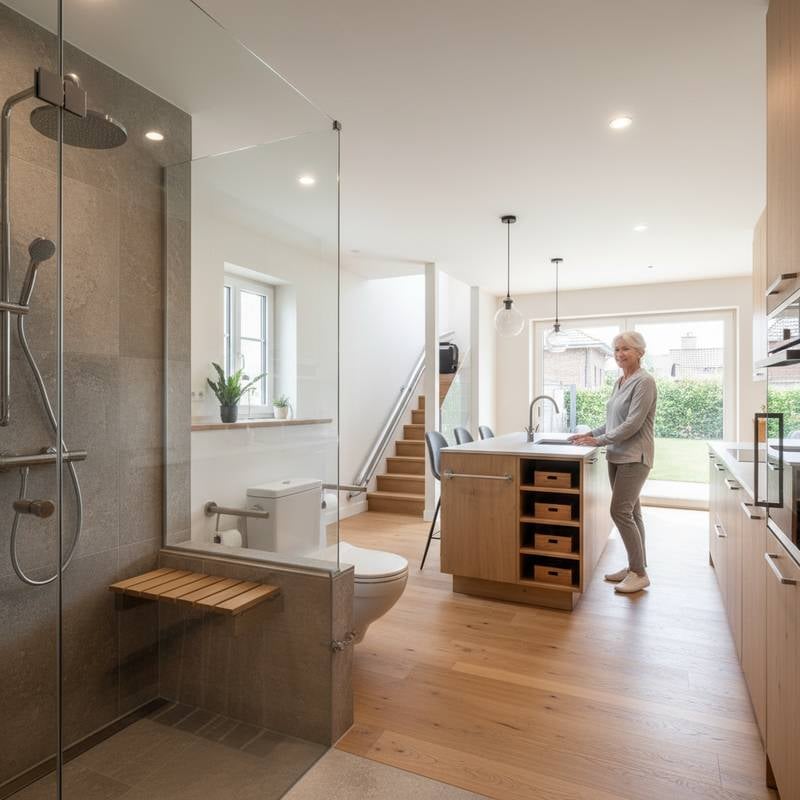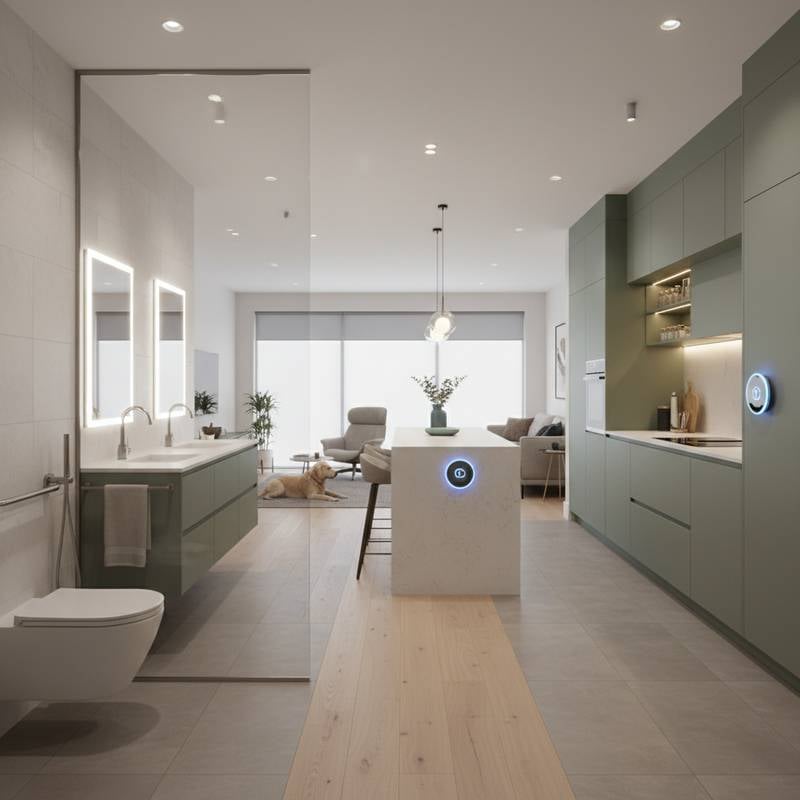Aging in Place in 2025: Essential Remodeling Costs and Features
Aging in place enables individuals to remain in their beloved homes while ensuring safety, comfort, and independence. Thoughtful remodeling enhances daily activities, supports mobility, and anticipates future requirements. This guide outlines critical features for aging-in-place updates, associated expenses, professional involvement, and investment strategies for sustained well-being.
Overview of Guide Topics
- Broad accessibility modifications throughout the home
- Essential kitchen and bathroom renovations
- Enhancements to entryways, lighting, and flooring
- Integration of technology and smart home systems
- Expense breakdowns and investment returns
- Guidance on DIY efforts versus hiring experts
- Strategies for ongoing maintenance and care
Primary Areas for Aging-in-Place Updates
1. Accessible Entryways and Doorways
Importance: Wide, unobstructed entryways facilitate secure movement for those using canes, walkers, or wheelchairs. Eliminating steps simplifies tasks such as carrying groceries or transporting furniture.
Expense Ranges:
- Doorway widening: $700 to $2,500 per opening
- Ramp installation: $1,500 to $6,000, based on length and materials
- Threshold leveling: $500 to $1,200
DIY or Professional: Experienced individuals might handle handrail or threshold ramp installations. However, doorway expansions or permanent ramp constructions demand licensed contractors to meet building codes.
Design Recommendation: Select durable, low-maintenance options like composite decking for ramps. Incorporate slip-resistant textures or adhesive strips to enhance traction.
2. Bathroom Safety and Accessibility
Importance: Bathrooms pose significant fall risks due to wet surfaces and confined spaces. Modifications promote easier access and reduce physical strain during personal care routines.
Expense Ranges:
- Grab bar installation: $200 to $500 per unit
- Walk-in shower conversion: $5,000 to $15,000
- Raised toilet or comfort-height fixture: $300 to $800
- Non-slip flooring upgrades: $400 to $1,200 per room
DIY or Professional: Simple grab bar mounting or bath mat placement suits DIY approaches. Plumbing alterations, shower remodels, or electrical additions for heated floors require certified specialists.
Design Recommendation: Opt for curbless showers with built-in benches. Install lever faucets and adjustable handheld showerheads to accommodate varying heights and abilities.
3. Kitchen Functionality and Accessibility
Importance: Kitchens serve as central hubs, yet traditional designs often demand excessive bending or stretching. Adaptations minimize effort and support prolonged independence in meal preparation.
Expense Ranges:
- Countertop lowering or multi-height surfaces: $1,000 to $4,000
- Pull-out shelves and lazy Susans: $200 to $600 per cabinet
- Side-hinged ovens or pull-out dishwashers: $1,500 to $3,000
- Under-cabinet task lighting: $300 to $800
DIY or Professional: Pull-out organizers and LED strips represent feasible DIY tasks. Counter modifications, appliance integrations, or wiring updates necessitate professional expertise.
Design Recommendation: Allocate at least 5 feet of clearance for turning radii. Employ matte surfaces to diminish glare and select pull-down cabinetry for upper storage.
4. Enhanced Lighting and Visibility
Importance: Adequate illumination eases visual tasks and prevents accidents. Aging eyes benefit from increased brightness and higher contrast levels.
Expense Ranges:
- LED fixture upgrades: $100 to $300 each
- Motion-activated outdoor lights: $200 to $500 per fixture
- Stairway or under-cabinet strips: $300 to $900
DIY or Professional: Swapping bulbs or using plug-in units qualifies as straightforward DIY work. Permanent wiring installations call for electrician oversight.
Design Recommendation: Combine ambient, task, and accent lighting layers. Select 3000K color temperature bulbs to deliver warm, inviting illumination without harshness.
5. Bedroom and Living Space Adaptations
Importance: These areas must prioritize rest and accessibility. Reachable storage and open layouts streamline routines and foster relaxation.
Expense Ranges:
- Adjustable bed frames: $900 to $2,000
- Custom closet systems: $1,000 to $3,000
- Hallway or door widening: $800 to $2,500
DIY or Professional: Furniture reconfiguration or reach extenders suit independent efforts. Outlet relocations or structural adjustments demand professional intervention.
Design Recommendation: Maintain 36-inch minimum pathways. Anchor area rugs with non-slip pads or tape to avoid tripping hazards.
6. Smart Home Technology Integration
Importance: Automation streamlines home management, from lighting control to security monitoring. Voice-activated systems empower users with limited mobility.
**Expense Ranges:**n- Smart hub or voice assistant: $100 to $300
- Automated door locks and lights: $150 to $400 per device
- Whole-home system setup: $2,000 to $5,000
- Fall detection sensors: $200 to $600
DIY or Professional: Basic device pairings and app configurations work for DIY. Complex networking or custom integrations require technicians.
Design Recommendation: Prioritize intuitive interfaces like voice commands. Integrate with existing Wi-Fi for seamless operation and energy savings.
Comprehensive Cost Analysis and Returns
Full aging-in-place projects span $10,000 for targeted updates to $75,000 for extensive overhauls. Factors influencing totals include property dimensions, material selections, and modification scope. Kitchen and bathroom enhancements typically yield superior resale value.
Projected Returns on Investment:
- Accessibility-focused bathroom renovations: 60 to 70 percent
- Kitchen adaptations: 50 to 65 percent
- Entryway and lighting refinements: 40 to 50 percent
Properties featuring universal design principles attract broader markets, accelerating sales and elevating values.
Strategies for Cost Efficiency
Remodeling represents a strategic investment. Prudent decisions preserve quality while managing budgets.
Savings Approaches:
- Prioritize bathrooms and entryways for immediate benefits
- Retrofit current elements rather than full replacements
- Bundle tasks to minimize contractor travel fees
- Explore regional grants or tax incentives for adaptations
- Obtain bids from at least three qualified providers
Incorporating energy-efficient elements, such as LED systems or programmable thermostats, further reduces operational expenses over time.
Frequently Asked Questions
**Which aging-in-place element merits initial attention?**nBathroom safeguards rank highest. Grab bars, slip-resistant floors, and barrier-free showers swiftly mitigate fall dangers.
**What doorway width supports accessibility?**nA 36-inch minimum ensures smooth navigation for mobility aids.
**Are permits required for these modifications?**nStructural, electrical, or plumbing alterations generally necessitate approvals. Consult local authorities prior to commencement.
**How accessible are smart devices for seniors?**nContemporary platforms emphasize simplicity, with voice controls and remote options available.
Implementing Your Remodel Plan
Aging in place extends beyond mere adaptations. It cultivates an environment that nurtures autonomy, security, and ease for decades ahead. Begin with a thorough home evaluation to pinpoint mobility or visibility obstacles.
Collaborate with universal design specialists to blend aesthetics and utility. Through deliberate planning, resilient materials, and innovative tools, individuals can thrive in familiar surroundings with assurance.










